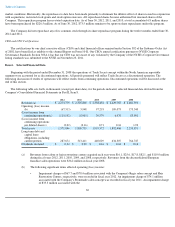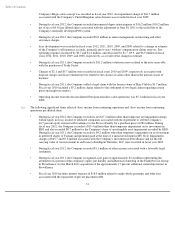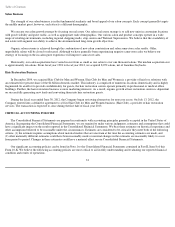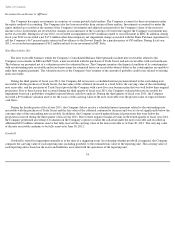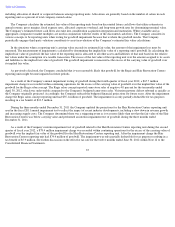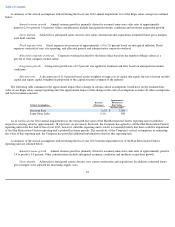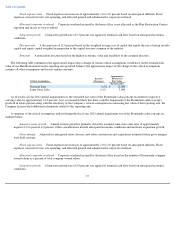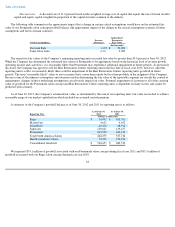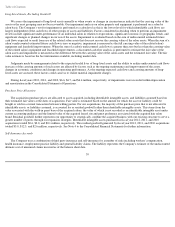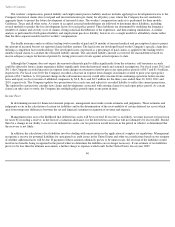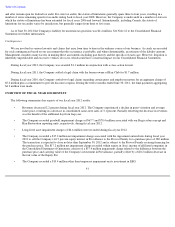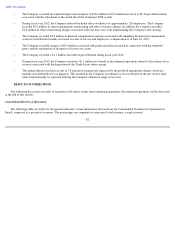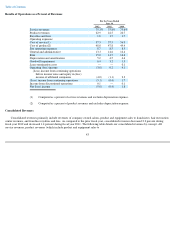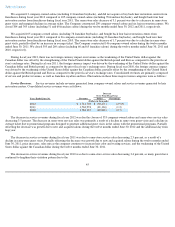Supercuts 2012 Annual Report Download - page 37
Download and view the complete annual report
Please find page 37 of the 2012 Supercuts annual report below. You can navigate through the pages in the report by either clicking on the pages listed below, or by using the keyword search tool below to find specific information within the annual report.
Table of Contents
including allocation of shared or corporate balances among reporting units. Allocations are generally based on the number of salons in each
reporting unit as a percent of total company-owned salons.
The Company calculates the estimated fair value of the reporting units based on discounted future cash flows that utilize estimates in
annual revenue, gross margins, fixed expense rates, allocated corporate overhead, and long-term growth rates for determining terminal value.
The Company's estimated future cash flows also take into consideration acquisition integration and maturation. Where available and as
appropriate, comparative market multiples are used in conjunction with the results of the discounted cash flows. The Company considers its
various concepts to be reporting units when testing for goodwill impairment because that is where the goodwill resides. The Company
periodically engages third-party valuation consultants to assist in evaluation of the Company's estimated fair value calculations.
In the situations where a reporting unit's carrying value exceeds its estimated fair value, the amount of the impairment loss must be
measured. The measurement of impairment is calculated by determining the implied fair value of a reporting unit's goodwill. In calculating the
implied fair value of goodwill, the fair value of the reporting unit is allocated to all other assets and liabilities of that unit based on the relative
fair values under the assumption of a taxable transaction. The excess of the fair value of the reporting unit over the amount assigned to its assets
and liabilities is the implied fair value of goodwill. The goodwill impairment is measured as the excess of the carrying value of goodwill over
its implied fair value.
As previously disclosed, the Company concluded that it was reasonably likely that goodwill for the Regis and Hair Restoration Centers
reporting units might become impaired in future periods.
As a result of the Company's annual impairment testing of goodwill during the fourth quarter of fiscal year 2012, a $67.7 million
impairment charge was recorded within continuing operations for the excess of the carrying value of goodwill over the implied fair value of the
goodwill for the Regis salon concept. The Regis salon concept reported same-store sales of negative 4.0 percent for the ten months ended
April 30, 2012, which was unfavorable compared to the Company's budgeted same-
store sales. Visitation patterns did not rebound as quickly as
the Company originally projected. Accordingly, the Company reduced the budgeted financial projections for future years. After the impairment
charge the Regis salon concept reporting unit had $35.1 million of goodwill. The impairment was only partially deductible for tax purposes
resulting in a tax benefit of $12.5 million.
During the three months ended December 31, 2011 the Company updated the projections for the Hair Restoration Centers reporting unit
used in the fiscal 2011 annual impairment test to reflect the impact of recent industry developments, including a slow down in revenue growth
and increasing supply costs. The Company determined there was a triggering event as it was more likely than not that the fair value of the Hair
Restoration Centers was below carrying value and performed an interim impairment test of goodwill during the three months ended
December 31, 2011.
As a result of the Company's interim impairment test of goodwill related to the Hair Restoration Centers reporting unit during the second
quarter of fiscal year 2012, a $78.4 million impairment charge was recorded within continuing operations for the excess of the carrying value of
goodwill over the implied fair value of the goodwill for the Hair Restorations Centers reporting unit. After the impairment charge the Hair
Restoration Centers reporting unit had $74.4 million of goodwill. The impairment was only partially deductible for tax purposes resulting in a
tax benefit of $5.9 million. See further discussion on the effective tax rate for the twelve months ended June 30, 2012 within Note 12 to the
Consolidated Financial Statements.
35







